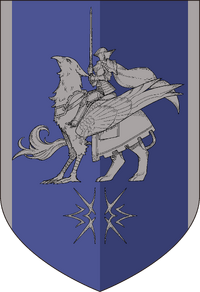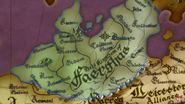
Banner of the Holy Kingdom of Faerghus
The Holy Kingdom of Faerghus (ファーガス神聖王国 Fāgasu-shinseiōkoku) is one of three nations on the continent of Fódlan.
Profile
The Holy Kingdom of Faerghus lies in the north of Fódlan, a cold, rugged land that has forced its people to adapt. It is ruled by the royal House Blaiddyd and a number of knightly orders. The nation was founded by Loog, the legendary King of Lions. Its capital city is Fhirdiad, which is also home to a prestigious school of sorcery. Holy Kingdom of Faerghus Founding Day is celebrated annually on the 21st of the Red Wolf Moon.
Garreg Mach Monastery in central Fódlan organizes its students into three houses, with each house representing a different nation. Students from the Holy Kingdom of Faerghus are members of the Blue Lions.
Military
The Kingdom's military is disciplined and instilled with a strong sense of chivalry and duty. The Kingdom army is known to rely on its knights, with House Gaspard and Gautier renowned for their cavalry while Galatea was famed for their pegasus.
Culture
Due to the harsh environment, children are trained to wield a weapon before they are taught to read and write. Since it was founded thanks to mediation from the Church of Seiros, the country's royal family and most nobles are both pious and enduring supporters of the church. As such, Dimitri readily grants Rhea and the knights of Seiros asylum after the Empire attacks the monastery in the Black Eagles route, and even fights the Empire's troops to the death to protect the archbishop.
History
Originally, the Holy Kingdom of Faerghus was part of the Adrestian Empire. In Imperial Year 747, Loog of House Blaiddyd, a direct descendant of one of the Ten Elites of the War of Heroes, led Faerghus in rebellion against the Adrestian Empire in the War of the Eagle and Lion. Loog claimed victory in 751, after defeating the Emperor at the Tailtean Plains. The Church of Seiros mediated between Faerghus and the Empire, resulting in the creation of the Holy Kingdom of Faerghus and Loog being crowned its first king.
In 801, the Leicester region also rebelled against the Empire, which was unable to reassert control. The Kingdom intervened by occupying and annexing Leicester as a protectorate. In 861, the three sons of the late King Klaus I divided the Kingdom into three archduchies: the Eastern Kingdom, the Western Kingdom, and Leicester. In 881, upon the death of Leicester's archduke, the nobles of Leicester rejected his heir and launched a second bid for independence upon the instigation of House Riegan, a cadet branch of the Blaiddyd royal family. The resulting Crescent Moon War ended in 901 with the nobles of Leicester seceding from Faerghus to form the Leicester Alliance.
In 1101, the Kingdom cooperated with the Empire and the Alliance to construct Fódlan's Locket, a fortress in the mountains of Fódlan's Throat, as a safeguard against further invasions from Almyra.
Around 1160, a plague ravaged the nation and the Queen Consort died shortly after giving birth to Crown Prince Dimitri in 1162. The mage Cornelia gained influence within the royal court after stopping the outbreak. Around 1168, King Lambert, accompanied by his trusted advisor Rodrigue, invaded Sreng and annexed the southern half of the region after the campaign's success. During the Insurrection of the Seven, Patricia von Arundel, the wife of Emperor Ionius IX of the Adrestian Empire, was betrothed to Lambert and did not return to the Empire when her daughter Edelgard departed Faerghus in 1174. Two years later, numerous nobles and royals, including King Lambert, Queen Consort Patricia, and Glenn, Rodrigue's firstborn son, were assassinated; only Dimitri survived. The people of Duscur were blamed for the attack and persecuted for regicide in what became known as the Tragedy of Duscur. The late king's brother, Grand Duke Rufus of Itha, assumed regency over the Kingdom in Dimitri's stead. In 1178, Dimitri distinguished himself by quelling a rebellion in the Kingdom's west. The Grand Duke's reign has led to a period of decline throughout the Kingdom. The nation is plagued by civil strife and hardship, rumors suggest the deterioration in governance is a result of the Regent's womanizing.
Possible futures
The Kingdom's history after 1180 differs depending on which student house that Byleth chose to teach at the Officers Academy.
"Just a minute! The following section contains spoilers. Viewing it will cost a lot. Are you prepared to pay for it?"
|
If any routes other than the Black Eagles were chosen, a bloody coup led by Cornelia causes Duke Rufus and Dimitri both to be apparently killed. With the vast majority of the former Kingdom lords having bent the knee to the overwhelming power of the Empire, all Blaiddyd territory, including the Kingdom capital, is ruled by those who are cooperating with the Empire, and is thus renamed the Faerghus Dukedom.
Locations
- Arianrhod
- Charon
- Conand Tower
- Fhirdiad (capital)
- Fraldarius
- Galatea
- Gaspard
- Gautier
- Gideon
- Itha Plains
- Kleiman
- Lake Teutates
- Magdred Way
- Mateus
- Rhodos Coast
- Rowe
- Sacred Gwenhwyvar
- Tailtean Plains
- Western Church
Family Tree
Notable People from Faerghus
Royalty
- Loog - Founder and first Ruler of the Holy Kingdom of Faerghus.
- Klaus I - Annexing Leicester region to Faerghus. His sons divided the Kingdom into three Archdukedoms after his death.
- Lambert Egitte Blaiddyd - Ruler of the Holy Kingdom of Faerghus until his death in 1176.
- Rufus - Older brother of Lambert and regent of the Kingdom.
- Dimitri Alexandre Blaiddyd - Crown prince of the Holy Kingdom of Faerghus. Known for his chivalry, it seems a darkness may lurk beneath the surface. House leader of the Blue Lions.
- Patricia von Arundel - King Lambert's second wife and former empress of the Adrestian Empire.
Nobility
- Rodrigue Achille Fraldarius
- Glenn Fraldarius (formerly)
- Felix Hugo Fraldarius
- Miklan Anschutz Gautier (formerly)
- Sylvain Jose Gautier
- Gustave Eddie Dominic (formerly)
- Annette Fantine Dominic
- Ingrid Brandl Galatea
- Cassandra Rubens Charon (formerly)
- Lonato Gildas Gaspard
- Christophe Gaspard
Military
Commoners
- Dedue Molinaro
- Mercedes von Martritz - The adopted daughter of a merchant family with a gentle, easygoing personality.
- Ashe Ubert
- Cornelia Arnim
Etymology
Faerghus is a variation of the name Fergus; an Irish, Manx and Scottish name meaning "man strength" or "virility". Likely from Fergus mac Róich of the Ulster Cycle.
The locations in Faerghus are likely to reference the Irish Ulster Cycle, Welsh Mabinogion and Arthurian folklore from England. Ferdiad is Cú Chulainn's foster brother from the Ulster Cycle, Arianrhod and Gwydion are siblings from the Mabinogion and Gwenhwyfar is Welsh for Guinevere, the queen of Camelot. Teutates was a Celtic god, now mainly known from the Asterix comics by Goscinny and Uderzo.
Blaiddyd was a legendary Brittonic king whose son Leir was the basis for Shakespeare's King Lear. Leir founded Cair Lerion, now known as the City of Leicester.





